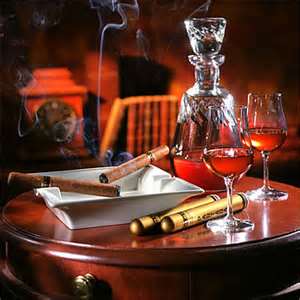Cognac is produced in a 317-square mile region on the west-central coast of France and named for the town of Cognac in its center. The town exported salt and wine in the 17th century and its wine was particularly popular with Dutch and English merchants. To reduce taxes on transportation of his wine, a vintner named Chevalier de la Croix-Marrons distilled the wine a second time and shipped it in oak barrels for it to be diluted to full volume upon arrival. Merchants discovered the distilled wine had a pleasant taste of its own, especially after aging in contact with the oak. The Dutch called it brandewijn, “burnt wine,” due to its double distillation. the English shortened it to brandy.
Cognac is an extremely fine type of brandy that meets strict requirements to bear the name. It must be made from particular white grapes of which Ugni Blanc, locally known as Saint Emilion, is the most widely used. These grapes are grown in the chalky soil of six specific subdivisions of the cognac region which are roughly a set of widening concentric circles. Grand Champagne, the center circle of the region which includes the town of Cognac, yields the most delicate and fragrant grapes. Petite Champagne, the next outward circle, produces grapes that mature faster and are bolder in taste. Grapes in the Borderies subdivision produce a rounder and softer taste while those from the outlying three circles are used primarily to flavor other brandies. Grapes are grown with about three meters of open space between rows so they receive optimal sunlight.
Grapes are pressed and juice is allowed to ferment naturally. Once fermented it is poured into 660-gallon copper pot stills enclosed in brick kilns. Kilns are heated, alcohol and some water vaporize and condense to a liquid about 30% alcohol. The liquid is heated a second time in an exacting process where the distiller separates the “heart” of the distilled liquid from the “head,” the first part of the distillate too high in alcohol content, and the “tail” which lacks substance at the end of the distillation process. The resulting liquid is 70% alcohol and about a third of its original volume.
Most major cognac producers build their own casks for aging. Trees a hundred years old and rich in tannin and vanillin from the forests of Limousin and Troncais are the primary wood used. They are spilt, not sawed, then stacked and seasoned in open air for three years. Coopers shape seasoned wood into barrels, binding staves together with metal bands so glue and nails, which would affect the flavor of the cognac, are not necessary.
The final distillate is stored in newer casks for the first year or two. The actual amount of time is dependent on the desired level of tannin which is strongest in new oak. Maturing cognac is progressively moved to older casks based on the particular product desired. The cooper presides over the transfer, tasting each barrel once a year to determine if its contents should be moved to another cask. A large cognac house might have 10,000 barrels aging in its cellars and each must be tasted annually. While one’s first thought might be “Are they accepting applications?” tasting involves only smelling to assess how a barrel is aging and to evaluate the cognac for its blending qualities. Barrel warehouses were originally built on rivers for ease of transport. The resulting damp cellars proved beneficial because the cognac evaporates more slowly and matures without losing volume so quickly.
 Cognacs from different vintages and subdivisions are blended over a period of one to several years to create the quality of final product desired. Some can be the result of blending up to a hundred different barrels. The age of the final cognac is that of the youngest in the blend. Each cognac house has a style consistent from year to year passed down through generations of the family.
Cognacs from different vintages and subdivisions are blended over a period of one to several years to create the quality of final product desired. Some can be the result of blending up to a hundred different barrels. The age of the final cognac is that of the youngest in the blend. Each cognac house has a style consistent from year to year passed down through generations of the family.
Cognac is bottled on a slow-moving assembly line in containers a source of great pride to each company. Many are handcrafted of crystal, sealed with wax, or draped with satin ornaments. Labels are marked V.S., “Very Special” at least two years in the cask, V.S.O.P., “Very Superior Old Pale” at least four years in the cask, or X.O., “Extra Old” stored at least six but up to twenty years or more.
